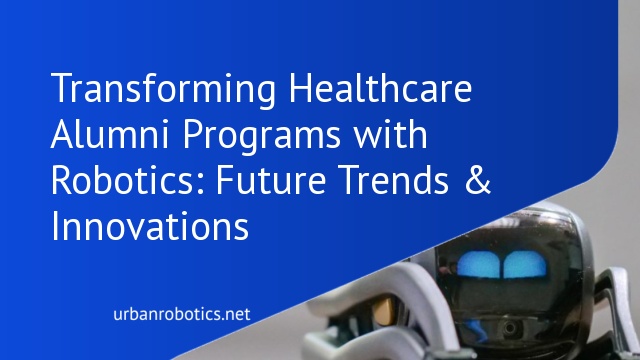Overview of Healthcare Alumni Programs
Healthcare alumni programs play a crucial role in maintaining professional networks and fostering continuous development. By staying connected, alumni can access invaluable resources, industry updates, and innovative technologies like robotics.
Importance of Alumni Programs in Healthcare
Healthcare alumni programs offer support networks essential for career growth and knowledge exchange. These programs provide continuing education opportunities and avenues for collaborations, which enhance professional competencies. For example, alumni can participate in workshops, conferences, and webinars, gaining insights into the latest medical advancements. Engaged alumni contribute to their alma mater, driving innovation and improving patient care outcomes.
Evolution of Alumni Programs
Alumni programs have evolved significantly over the years. Initially focused on social networking, these programs now encompass professional development and technological integration. Today, many healthcare institutions incorporate advanced tools, such as robotics, into their alumni programs. This evolution ensures that alumni remain proficient with emerging technologies, directly impacting patient care quality. Institutions leverage online platforms, virtual labs, and simulation technologies to keep alumni informed and skilled.
Integration of Robotics in Healthcare
Robotics has revolutionized healthcare by enhancing precision, efficiency, and outcomes. It’s crucial to understand how robotics has advanced and the benefits it offers in medical practices.
Advancement of Robotics in Healthcare
Robotics has made significant strides in healthcare over the past decade. Robots assist in surgeries, rehabilitation, and diagnostics. For instance, the Da Vinci Surgical System enables minimally invasive procedures with high precision, reducing recovery times. Robotic exoskeletons aid in rehabilitation by supporting patient mobility and strength recovery. Diagnostic robots, equipped with AI, perform tasks like scanning and data analysis, providing faster and more accurate results.
Benefits of Robotics in Medical Practices
Robotics offers numerous benefits in medical practices. Enhanced precision reduces human error during surgeries, improving patient outcomes. Automated systems increase operational efficiency, handling repetitive tasks and freeing up healthcare professionals for complex cases. Robotic technology contributes to shorter hospital stays and quicker recovery, resulting in cost savings. Some robots even provide valuable data analytics, aiding in predictive medicine and personalized patient care planning.
Combining Alumni Programs with Robotics
Healthcare alumni programs benefit significantly from integrating robotics, creating unique opportunities for continuous learning and collaboration among professionals.
Case Studies of Successful Healthcare Alumni Programs with Robotics
Several healthcare institutions have successfully integrated robotics into their alumni programs. For instance, Johns Hopkins University launched a robotics training module as part of its alumni initiative, allowing former students to learn new surgical techniques. Another example is Cleveland Clinic’s alumni association, which partners with robotics firms to offer workshops on the latest robotic diagnostic tools. These programs not only keep alumni engaged but also ensure they remain at the forefront of technological advancements.
Enhancing Alumni Participation Through Robotics
Robotics can significantly enhance alumni participation in healthcare programs. By offering hands-on workshops and virtual simulators, alumni can actively engage in learning new technologies. Mayo Clinic’s alumni program, for example, uses robotic simulation tools in its continuing education sessions. Similarly, Stanford Medicine incorporates interactive robotic webinars, which allow alumni to participate remotely. By leveraging robotics, these programs maintain high levels of alumni engagement and foster a culture of continuous improvement.
Challenges and Considerations
Integrating robotics into healthcare alumni programs comes with its own set of challenges and considerations. Addressing these issues is crucial for the successful adoption of robotics in continuing medical education.
Technological Barriers
Implementing robotics in alumni programs often faces technological barriers. High costs of advanced robotic systems can limit accessibility for many institutions. Additionally, the need for specialized infrastructure and technical support presents challenges. In rural areas, limited bandwidth and poor internet connectivity hinder the effective use of virtual simulators and interactive webinars. Ensuring all participants have access to the required technology is essential to overcoming these barriers.
Ethical and Privacy Concerns
Using robotics in healthcare alumni programs also raises ethical and privacy concerns. Collecting and storing data from robotic simulations must comply with relevant regulations to protect personal information. There is a risk of sensitive patient data being exposed during training sessions if proper safeguards aren’t in place. Ethical considerations include ensuring that the use of such technology does not lead to the depersonalization of patient care. Addressing these concerns is critical to maintaining trust and integrity in the educational programs.
Future Trends
Healthcare alumni programs with robotics are set to transform as technology advances. Future trends point toward significant innovations and impactful predictions.
Innovations on the Horizon
Robotics in healthcare education promises advanced AI integration, enhancing diagnostic accuracy. Wearable robotic devices (e.g., exoskeletons) will aid physical therapy, helping alumni extend practical knowledge. Virtual Reality (VR) simulators will become more sophisticated, providing realistic surgical training experiences. More institutions will adopt these tools, reducing training costs and increasing access.
Predictions for the Next Decade
In the next decade, alumni programs will leverage 5G for real-time, remote-controlled robotic surgeries, offering hands-on experience globally. Blockchain will secure patient data during training, addressing ethical concerns. We expect a surge in telehealth advancements, with robotics enabling remote diagnostics and treatment. Alumni will benefit from continuous skill updates and diverse global interactions, shaping more effective healthcare professionals.
Conclusion
Healthcare alumni programs integrating robotics are transforming how professionals stay current and connected. By embracing advanced technologies like AI and VR simulators, these programs are setting new standards in patient care and medical education. Despite challenges like high costs and ethical concerns, the future is promising with innovations such as 5G-enabled surgeries and blockchain for data security. As we look forward, these advancements will ensure our alumni have the tools and knowledge to lead in a rapidly evolving healthcare landscape. With continuous updates and global interactions, we’re poised to shape more effective and innovative healthcare professionals.





